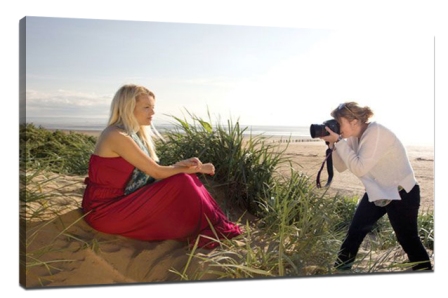What are the most common mistakes in photograph
What are the most common mistakes in photograph
1. overexposure
If your photos appear in white areas with no details, canvas print it means that the photos are overexposed. That is to say the amount of light that the sensor gains is much higher than that required for correct exposure. The reason why this happens is that the combination of ISO value, aperture and shutter speed is problematic and, of course, related to the brightness of the scene. In principle, in order to let the sensor receive less light, it can reduce the aperture, shorten the shutter speed, and reduce the ISO value, but other factors should be considered before making such an adjustment.
The overexposed area in the image can also be slightly darker through targeted post processing, so that some details can be seen. It is necessary to distinguish between the overexposed area and the brighter image area, because the latter may only appear to be pure white, but in fact there are details. This difference can be seen through the histogram on the camera screen when shooting. If the image area is swallowed by white, the right side of the histogram will be cut off.
If the image is overexposed, the brighter image area will be swallowed up. That is to say, the area cannot see any details at all, only pure white. Usually, this happens when you are metering errors or manually set up errors.
2. insufficient exposure
Too little light reaching the sensor leads to insufficient exposure. This is the case because the combination of the aperture, the shutter speed, and the ISO value is problematic. The end result is a black and no detail area in the image. Worse still, because the amount of light is too small, the area will cause interference noise.
However, when it is impossible to determine how to do better, it is better to be less exposed and not overexposed, because white "eroded" information is more than the black "submerged" information. It is also important to not confuse the overexposure and lack of exposure with high-profile and low-key shots. Although there will be areas of light and deep tone in high and low profile images, there are details in these areas.
When exposed, the sensor gains too little light, so that the charges generated by light cannot be distinguished from the basic charge of the sensor itself. The result is usually unattractive variegated and clear noises that should have been in black areas.

3. focus error
The clear area in the image is not in the expected focus, because the photographer's attention is not focused or his hands are too unstable. If the focus area is adjusted after the focus is adjusted and the camera is moved slightly forward or backward, the set focal plane will be moved to the front or rear of the focus body.
To prevent this problem, you are recommended to use the autofocus mode that can choose the focus area and select the focus area similar to the point you want to focus. In addition, increasing the depth of field also helps solve this problem, that is, to reduce the focal length or aperture. If it still doesn't work, check the autofocus mode of the camera to see if it is calibrated.
It is important to focus on the right position, especially in portrait photography. The eye of a model is not always on the focal plane, which is usually regarded as a focusing error.
4. jitter
If there is a wobble in the shooting, it will form a ghost map, that is, the subject is repeatedly appearing on the image and is not clear. The reason for this problem is that the exposure time is too long: when the shutter is opened and the light is irradiated to the sensor, the camera or subject is moved. When the shutter speed is high, the photographer can also hold a camera with a camera that does not shake, depending on the focal length used: the longest shutter speed of the jitter is the reciprocal of the focal length (multiplied by the current picture coefficient).
For example, when the focal length is 150 mm, the longest shutter speed is 1/150 s. The shutter speed is slightly short, but if the shutter speed is longer than that, the three foot frame or the optical anti shake system can be used to produce a jitter free image. If you choose to use the three tripods, ensure that the camera does not shake when pressing the shutter release key. In addition, you can also use the camera's automatic shutter function or shutter remote control.
When the shutter is a long time, moving can lead to a blurred, jitter "Ghost Map" - whether the subject is moved, the camera moves, or the photographer moves.
Recent Posts
-
How to Personalize Your Canvas Prints
Canvas prints are a popular way to bring art, photos, and memories to life in your home. Whether you …26th Nov 2024 -
How Mug Prints Can Elevate Your Cafe’s Branding
In the competitive café industry, creating a memorable and cohesive brand is essential for attractin …21st Nov 2024 -
Incorporating Canvas Prints into Your Holiday Décor: Transform Your Space with Festive Art
Create a Magical Holiday Vibe with Canvas PrintsThe holiday season is the perfect time to transform …20th Nov 2024
